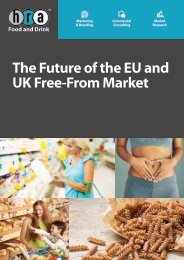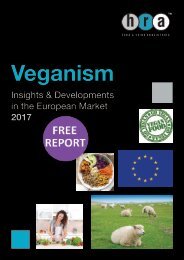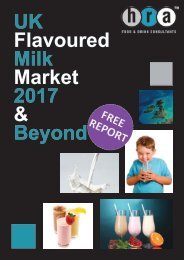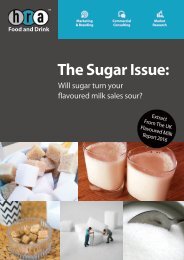FREE-UK-Flavoured-Milk-Report-2016-2017
The backdrop to the UK flavoured milk market is one of relentless change. The removal of the EU milk quotas, the transition to a Western-type diet by emerging economies, the UK sugar debate and the booming sports nutrition industry are all aspects of change that create both challenges and opportunities for the UK flavoured milk market. HRA Food and Drink Marketing has developed this report as a map to guide industry stakeholders. Although volume growth in 2014 was slightly lower than in previous years, the flavoured milk market still has plenty of room for product innovation and development. Overall, we expect the UK flavoured milk market to continue to grow over the medium term, but not without improving its nutritional profile. The sugar debate reached new heights when, in October 2015, Public Health England released a document suggesting Government intervention in the form of a sugar tax (levy). As a consequence, product reformulation has become a priority for all serious players in the market.
The backdrop to the UK flavoured milk market is one of relentless change. The removal of the EU milk quotas, the transition to a Western-type diet by emerging economies, the UK sugar debate and the booming sports nutrition industry are all aspects of change that create both challenges and
opportunities for the UK flavoured milk market.
HRA Food and Drink Marketing has developed this report as a map to guide industry stakeholders. Although volume growth in 2014 was slightly lower than in previous years, the flavoured milk market still has plenty of room for product innovation and development.
Overall, we expect the UK flavoured milk market to continue to grow over the medium term, but not without improving its nutritional profile. The sugar debate reached new heights when, in October 2015, Public Health England released a document suggesting Government intervention in the form of a sugar tax (levy). As a consequence, product reformulation has become a priority for all serious players in the market.
You also want an ePaper? Increase the reach of your titles
YUMPU automatically turns print PDFs into web optimized ePapers that Google loves.
<strong>UK</strong>#FLAVOURED#MILK#<strong>2016</strong>217#<br />
#<br />
2.! Evolution of the <strong>Flavoured</strong> <strong>Milk</strong> Category<br />
It is important to understand the historic behaviour of the <strong>UK</strong> flavoured milk<br />
market in order to put what is currently happening in the market into context.<br />
<strong>Flavoured</strong> milk value and volume sales have shown an overall positive<br />
compound annual growth rate since 2009 and the category is one of<br />
relatively few categories in the grocery market to exhibit positive and<br />
sustained value growth. This growth has come at a price with a pattern of<br />
heavily-discounted promotions being established which has weakened brand<br />
loyalty. The high growth has also attracted a variety of new entrants into the<br />
category, which has in turn, driven innovation and widened consumer choice.<br />
This contrasts with white milk where the market has declined in value<br />
recently despite volumes increasing as a result of the retailer milk price wars<br />
which are driving down unit prices and encouraging purchase of larger<br />
volumes. The fall in market value is due to a variety of factors but, as we will<br />
see later on, the removal of the EU milk quota system has had a significant<br />
effect on white milk production, with increased supply and global market<br />
over supply driving prices down. However, arguably the most significant<br />
factor in the category’s value issues is price competition between<br />
supermarkets.<br />
This chapter summarises pictorially recent flavoured milk product launches.<br />
In the past five years, every year has seen an increase in the variety of<br />
flavoured milk products launched into the market. NPD continues to be a<br />
strong driver of growth.<br />
This growth in NPD reflects increased consumer demand, the need for<br />
dairies to develop value-added milk products to make use of increased white<br />
milk production, an increase in brands needing to differentiate themselves<br />
from competitor products and technological advances as well as the need for<br />
brands to constantly innovate flavours, propositions and packaging to create<br />
points of difference.<br />
# 21#<br />
All rights reserved, ©Teepee#Ltd,#t/a#HRA#Food#&#Drink:#<strong>2016</strong>#<br />
to#<strong>2017</strong>#







